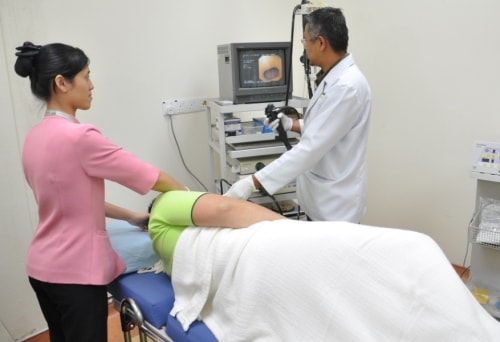Cancer risk from gastroesophageal reflux
The disease occurs over a long period of time, causing the esophageal mucosa to change like the intestinal mucosa, which can turn into esophageal cancer.
Gastroesophageal reflux disease is a common disease, the rate of which is increasing. The disease is quite common but many cases are not diagnosed correctly. This is a chronic disease, so treatment must be long-term, even when the symptoms have disappeared.
Dr. Nguyen Phuoc Lam, Head of the Department of Gastrointestinal Endoscopy, Thanh Do International Hospital, said that the specific symptom of the disease is heartburn. The disease can also manifest in other symptoms such as chest pain, prolonged cough, sore throat... which can easily be confused with heart and lung diseases, pharyngitis. Sometimes the disease has no symptoms at all, and is only discovered during endoscopy or when complications arise.
Gastroesophageal reflux can easily lead to esophageal ulcers, if severe and prolonged, it can lead to esophageal stricture. Esophageal ulcers can also cause bleeding. The disease occurs over a long period of time, causing the esophageal mucosa to change like the intestinal mucosa, called Barrett's esophagus. Barrett's esophagus is a precancerous lesion that can turn into cancer. Once it turns into Barrett's esophagus, it cannot be completely treated with medication but needs to be closely monitored by endoscopy. If there are signs of a high risk of turning into cancer, intervention by procedure or surgery is required.
In some patients, especially children and the elderly, aspiration of refluxed fluid into the airways can cause pneumonia.
 |
| Many cases of gastroesophageal reflux have no symptoms at all, and are only discovered during endoscopy or complications. Illustration: promise. |
Signs of reflux esophagitis
In children, the signs are vomiting, the vomit has a sour smell of gastric juice. Less common are wheezing, anorexia, slow growth, and pneumonia.
In older children and adults, typical symptoms are heartburn, sour taste in the throat, burning or pain in the chest, feeling of food stuck when swallowing. Other symptoms include hoarseness and sore throat in the morning, bad breath. Symptoms often appear after eating or at night. Symptoms are reduced when the patient takes antacids such as Phosphalugel or acid-reducing drugs such as Cimetidine, Omeprazone.
Causes of gastric reflux into the esophagus
There are many theories about the cause of gastroesophageal reflux disease. The theories focus on the tissue that functions as a valve at the junction of the esophagus and stomach. In people with gastroesophageal reflux, this valve does not function properly, the closing pressure is weaker than normal, the valve opens at inappropriate times, making it easy for stomach contents to flow back into the esophagus.
In addition to a weakened valve, other factors that contribute to worsening reflux include obesity, hiatal hernia, food remaining in the stomach for a long time, pregnancy, smoking, alcohol, certain foods and medications.
Diagnosis of gastroesophageal reflux
Belching, heartburn, and acid reflux can be normal physiological signs if they only occur transiently and do not cause discomfort. If these symptoms occur frequently, at a more severe level, making the patient feel uncomfortable or causing esophagitis, they are considered pathological.
Typical symptoms of the disease are heartburn, belching, burning sensation behind the sternum, sore throat, sour taste in the mouth. This symptom is worse at night, in a lying position. If the patient has these typical symptoms and there are no warning signs of serious illness such as difficulty swallowing, painful swallowing, weight loss, anorexia, anemia, gastrointestinal bleeding, symptoms that have recently appeared in the elderly (over 50 years old), the patient will be diagnosed with gastroesophageal reflux and treated for a period of 4-8 weeks.
After the treatment period, if the patient does not recover, they will have an esophagogastric endoscopy for diagnosis. Paraclinical diagnostic methods are used if the patient has unclear symptoms, doubts about the diagnosis, does not respond to treatment or has signs of serious illness. The test method commonly used to diagnose the disease is esophagogastric endoscopy. Measuring the pressure of the lower esophageal sphincter and measuring the pH of the esophagus is only applied in special cases.
Some notes when treating the disease
- Changing your lifestyle is the first and most important step in treatment. You need to change your diet, abstain from alcohol, coffee, tobacco, greasy foods, sour and spicy foods, and carbonated drinks.
Do not eat too much food, divide into smaller meals, do not eat late at night, do not lie down within 2 hours after eating, do not drink too much water while eating.
Sleep with your head 15 cm higher than your feet. Lose weight if overweight or obese, and stop taking stomach stimulants.
- Medication: Patients are given drugs that increase esophageal sphincter contractions, drugs that empty the stomach quickly, drugs that reduce stomach acid, drugs that antacid...
- Surgery is usually reserved for severe cases of esophageal ulcers that do not respond to medical treatment, are accompanied by hiatal hernia or complicated gastroesophageal reflux.
Foods that people with gastroesophageal reflux should not eat:
- Foods high in fat. These foods reduce the contraction of the lower esophageal sphincter, causing food to remain in the stomach for a long time, thus making reflux more likely.
- Fruits are good for health but there are also some that make acid reflux worse because they contain a lot of acid, such as oranges, lemons, grapefruits, tomatoes, star fruit, tamarinds... Patients should limit their intake, especially sour fruits.
- Chocolate: Contains methyxanthine, which reduces spasms of the lower esophageal sphincter, thereby allowing gastric juice to reflux into the esophagus.
- Pepper, chili, onion, garlic, mint... irritate the stomach and increase the possibility of reflux.
The following foods may help relieve reflux symptoms:
- Yogurt.
- Peanut butter.
- Foods rich in fiber such as papaya, beans, apples, avocado, broccoli, artichokes... are good for health, good for digestion and reduce gastroesophageal reflux.
According to VnExpress

.png)






